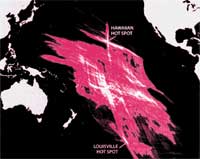


a new method presented by Paul Wessel and Loren W Kroenke at a recent meeting of the American Geophysical Union offers a way to locate hot spots under the ocean more easily and precisely than ever before ( Scientific American, Vol 276, No 4).
Described as hot-spotting, the technique depends on a new appreciation of some basic geometry. Previously, geologists required the age of various volcanoes created by a hot spot to determine its position. By studying the past motions of the overlying plate relative to fixed hot spots, they could trace backward along a chain of volcanoes and project to the site of rising magma. But doing so for an oceanic plate is a challenge, because ascertaining the ages of dormant, submerged volcanoes (seamounts) is plagued with difficulties
Links:
[1] http://admin.indiaenvironmentportal.org.in/news/hot-spotting
[2] http://admin.indiaenvironmentportal.org.in/category/newspaper/down-earth
[3] http://admin.indiaenvironmentportal.org.in/category/thesaurus/volcanic-eruptions
[4] http://admin.indiaenvironmentportal.org.in/category/thesaurus/energy
[5] http://admin.indiaenvironmentportal.org.in/category/thesaurus/geology